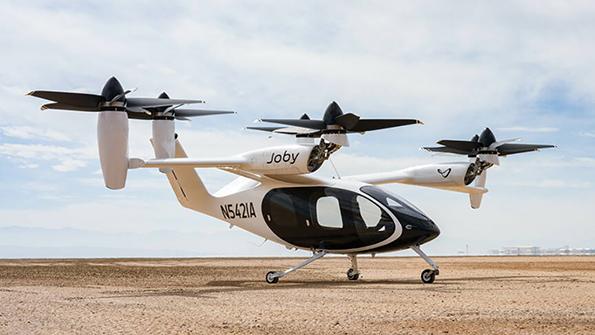
Joby Aircraft on Sept. 25 delivered the first of nine S4 electric vertical-takeoff-and-landing vehicles to Edwards AFB, California. NASA is studying the S4 to assess its suitability as an inflight trainer for Artemis lunar landing techniques.
When NASA awarded contracts to SpaceX and Blue Origin to fly astronauts between lunar orbit and the surface of the Moon, it retained pilot landing training for itself.
One option would be to design and procure simulators and trainers, such as NASA did under the Apollo program, which landed six crews on the Moon from 1969 to 1972. To analyze and practice lunar landing techniques—the force of gravity on the Moon is one-sixth of Earth’s—NASA purchased two Lunar Landing Research Vehicles (LLRV) and three follow-on Lunar Landing Training Vehicles (LLTV) from Bell Aerosystems for Apollo pilot training. (Parent company Bell Aircraft built the famed Bell X-1, which Chuck Yeager flew in 1947 to become the first person to break the sound barrier.)
- NASA is considering motion, inflight lunar lander trainers
- Joby delivers first S4 to Edwards AFB
One LLRV and two LLTVs were destroyed in crashes, with the pilots safely ejecting. A 2005 NASA History Office monograph on the LLRV called them “unconventional, contrary and ugly.” Apollo 8 astronaut Bill Anders wrote they were “a much unsung hero of the Apollo Program.”
For NASA to go that route today would be expensive and time-consuming. The first lunar landing under the Artemis program is targeted for late-2025 or 2026. NASA’s proposed fiscal 2024 budget includes nearly $8 billion for deep-space exploration, with $1.9 billion earmarked to support SpaceX’s and Blue Origin’s lunar landing systems development.
Another option comes from NASA’s aeronautics portfolio. NASA has an interagency agreement with the Air Force Research Laboratory’s AFWerx technology directorate to test Joby Aviation’s S4 electric vertical-takeoff-and-landing (eVTOL) aircraft.
Joby delivered the first of nine eVTOLs under a $131-million AFWerx Agility Prime contract to Edwards AFB, California, on Sept. 25.
Initially, NASA’s S4 testing is planned to focus on exploring ways to integrate air taxis and other new types of aircraft into the national airspace through its Advanced Air Mobility mission.
“Starting in 2024, NASA pilots and researchers will be working with the Joby aircraft to test how this type of aircraft could be integrated into a representative city environment,” the agency said in an email to Aviation Week.
Informally though the S4 may loom large in NASA’s Artemis program. In the summer of 2020, NASA’s Human Landing System (HLS) program, headed by Lisa Watson-Morgan at the Marshall Space Flight Center, formed an independent Joint Test Panel (JTP) to figure out how to train crews to get safely back to the Moon.
NASA also solicited industry for potential motion simulators and inflight trainers that could be used to prepare Artemis astronauts to land multiple types of vehicles on the lunar surface. SpaceX is under contract to provide the first two Artemis Moon landings. The company is developing a version of its Starship spacecraft to land astronauts on the Moon and return them to awaiting NASA spacecraft in lunar orbit. Blue Origin was contracted for the third Artemis landing.

California-based Joby Aircraft was among the respondents to NASA’s summer 2020 request for information. After collaborations with the Armstrong, Glenn, Langley, Johnson and Marshall field centers, the JTP in December 2020 recommended to NASA’s HLS program that it track two platforms:
The U.S. Navy’s GL-6000 disorientation research device—better known as “The Kraken”—located at the Naval Medical Research Unit’s Capt. Ashton Graybiel Acceleration Research Facility at Wright-Patterson AFB, Ohio. The Kraken provides six degrees of freedom and up to 3g of force.
The JTP plans to assess The Kraken as a motion-based simulator for lunar landings and make a recommendation to NASA’s HLS program mid-2024 about whether it provides the required motion control and simulation. Veteran astronaut Doug Wheelock, who co-chairs the JTP, kicked off Kraken testing in March, using visuals from the 1971 Apollo 15 approach.
“It was steeper [than previous approaches], coming in over the mountain range and landing just short of the canyon,” Wheelock tells Aviation Week. “They landed on a slope, which is what we’re concerned with as well.
“We flew that approach under lunar landing simulation in The Kraken. It was all open-loop, so there was no manual control in it, but we did a landing zone redesignation and it worked out beautifully,” he explains.
The Kraken is being developed to support closed-loop, manual-control lunar landing simulation runs as soon as late October, he says.
The Joby Aviation S4 eVTOL “popped out” as the leading candidate to pursue for a possible inflight trainer platform, Wheelock says. “We do not have a contract on it,” he notes.
“Our first S4 data points for HLS are going to be purely [of the computational fluid dynamics] type,” Wheelock notes. “I gave Joby the data points in low gate—essentially from 1,500 ft.-to-surface with about 2 km [(1.2 mi.)] distance. They’re going to run simulated lunar trajectories . . . just to make sure that the vehicle could support the rates of descent and the maneuvering requirements.”
The initial runs will take place in simulators, followed by remotely piloted S4 runs at Edwards to prove the fidelity of the simulation. “If those points prove to be good—or we’ll see if we need to expand or tighten those boundaries—then we launch the flight test in 2024 and fly those same simulated lunar runs with a pilot on board as well,” Wheelock says.
“We intend to exploit the all-electric vehicle and the fully reprogrammable flight control system on it,” Wheelock says, noting the S4’s six electric motors—four on the wings and two on the V-tail—can be controlled independently.
“You can turn it into a craft that can mimic, certainly in pitch, any kind of lunar dynamics,” he points out. “That’s going to be essential because the first lander is the SpaceX Starship, which is like a 10-story building.”
Based on Apollo landing trajectories, the Artemis HLS vehicles likely will dampen out early lateral or yaw motions, essentially leaving just pitch modulations. “At the end, we can do a little bit of yaw, just to avoid putting one of the legs on top of a rock or down into a crater or something like that,” Wheelock says.
After assessing the S4’s dynamics in simulated lunar space, Wheelock says he will make a clear recommendation to NASA headquarters whether to acquire the system. NASA adds it has begun to explore options for software and aircraft to train astronauts for piloting a human landing system and that it has not taken steps to acquire such an aircraft from Joby to date.
